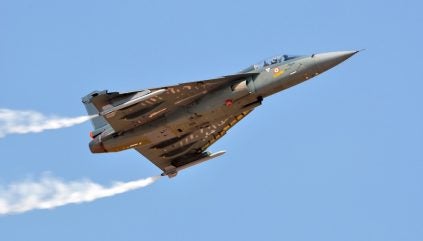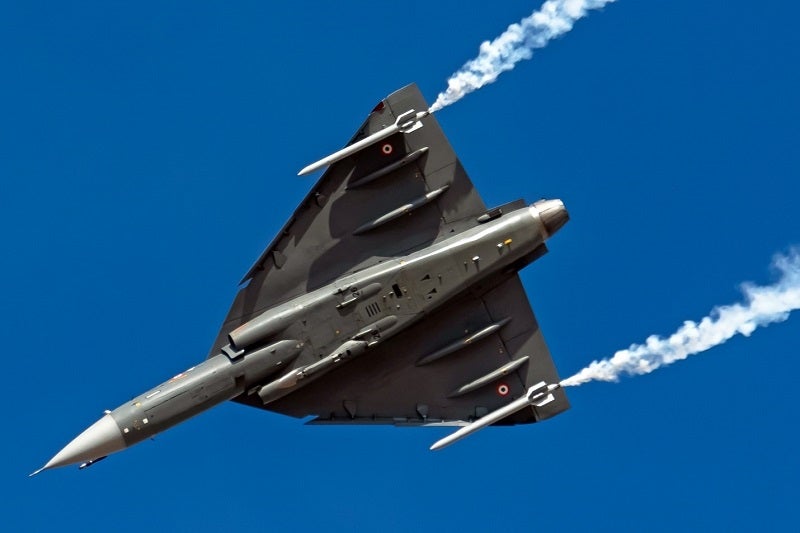
As part of the Indian Government’s campaign for a self-reliant defence industry, it has contracted a domestic supplier, the Aeronautical Development Establishment, to integrate a new ‘Digital Fly by Wire Flight Control Computer’ (DFWCC) to a prototype of the latest iteration of the Air Force’s Tejas light combat aircraft (LCA).
The prototype – the Mark (Mk) 1A version – is said to incorporate more than 40 improvements over the original Mk1 version, which entered service in 2016.
Designated ‘LSP7’, the newly integrated Mk1A prototype LCA successfully flew on 19 February, 2024. According to a Government statement, “all critical parameters and performance of the flight controls were found [to be] satisfactory.”
Wing Commander Siddarth Singh KMJ (Ret’d) of the National Flight Test Centre piloted the Mk1A maiden flight.
Tejas evolution and features
The Tejas LCA is a single-seat, single-engine, lightweight, high-agility supersonic fighter currently in active service in the Indian Air Force (IAF). As of December 2019, Tejas had flown 4,599 test flights up to speeds of Mach 1.4.
The aircraft’s design and development programme was led by the Aeronautical Development Agency (ADA) of the Indian Ministry of Defence, with Hindustan Aeronautics Limited (HAL) as the prime industrial contractor.
How well do you really know your competitors?
Access the most comprehensive Company Profiles on the market, powered by GlobalData. Save hours of research. Gain competitive edge.

Thank you!
Your download email will arrive shortly
Not ready to buy yet? Download a free sample
We are confident about the unique quality of our Company Profiles. However, we want you to make the most beneficial decision for your business, so we offer a free sample that you can download by submitting the below form
By GlobalDataThere is also a naval variant, which successfully completed a flight test aboard the Indian Navy’s aircraft carrier, INS Vikramaditya in 2020.
Tejas has a delta design with shoulder-mounted delta wings. It has a fin but no horizontal tail. Lightweight materials, including aluminium, lithium and titanium alloys, and carbon composites, have been used in the construction.
It has eight external hardpoints to carry stores: three under each wing, one on the centre fuselage, and one installed under the air intake on the port side.
The platform can deploy air-to-air, air-to-ground and anti-ship missiles, precision-guided munitions, rockets and bombs. Electronic warfare, targeting, surveillance, reconnaissance or training pods can be carried on the hardpoints.
In November 2016, the Defence Acquisition Council of India cleared the acquisition of 83 units of the next iteration, the Tejas Mk1A variant, bringing the total number of orders to 123.
In October last year, the Indian media reported that the first Mk-1A will be delivered to Air Force in February 2024, while the last of the 83 jets by 2028 (instead of 2029, the contracted delivery schedule).
The improved Mk1A version features advanced mission computer, high performance DFCC, Smart Multi-Function Displays, Advanced Electronically Scanned Array Radar, Advanced Self-protection Jammer, Electronic Warfare Suit, among other capabilities.

“A step toward Atmanirbharata”
Raksha Mantri Shri Rajnath Singh, India’s Defence Minister, complimented the joint teams from the IAF, ADA and industries involved in the development and successful flight test of this critical system for Tejas Mk1A.
“It as a major step towards Atmanirbharata [Self-Reliant India] with reduced count of special imports.”
In a press release covering the Prime Minister Narendra Modi’s visit to the original equipment manufacturer, HAL, at its facility in Bengaluru at the end of November 2023, the government stated that the indigenous content of the Mk1A is expected to surpass 70% in the next four years. As of 2022, 59.7% of the current Mk1 variant was indigenously produced.



